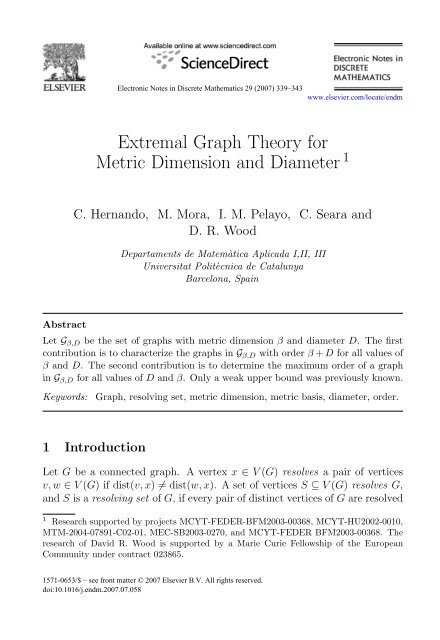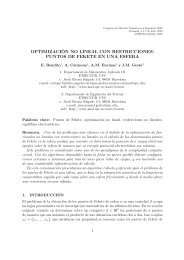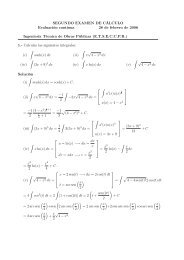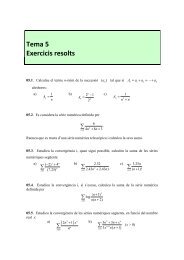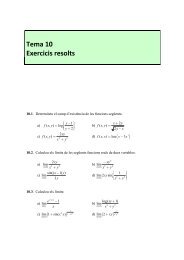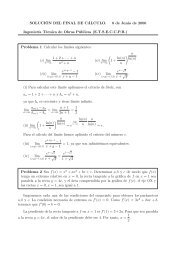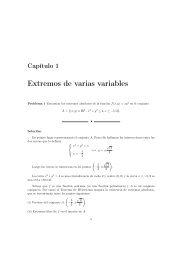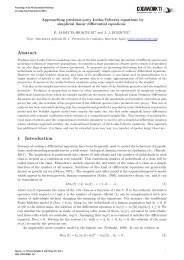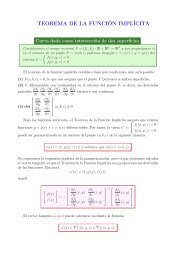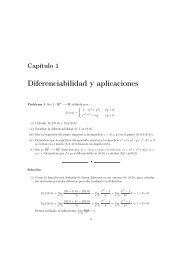Extremal Graph Theory for Metric Dimension and Diameter
Extremal Graph Theory for Metric Dimension and Diameter
Extremal Graph Theory for Metric Dimension and Diameter
You also want an ePaper? Increase the reach of your titles
YUMPU automatically turns print PDFs into web optimized ePapers that Google loves.
Electronic Notes in Discrete Mathematics 29 (2007) 339–343<br />
www.elsevier.com/locate/endm<br />
<strong>Extremal</strong> <strong>Graph</strong> <strong>Theory</strong> <strong>for</strong><br />
<strong>Metric</strong> <strong>Dimension</strong> <strong>and</strong> <strong>Diameter</strong> 1<br />
C. Hern<strong>and</strong>o, M. Mora, I. M. Pelayo, C. Seara <strong>and</strong><br />
D. R. Wood<br />
Departaments de Matemàtica Aplicada I,II, III<br />
Universitat Politècnica de Catalunya<br />
Barcelona, Spain<br />
Abstract<br />
Let G β,D be the set of graphs with metric dimension β <strong>and</strong> diameter D. The first<br />
contribution is to characterize the graphs in G β,D with order β + D <strong>for</strong> all values of<br />
β <strong>and</strong> D. The second contribution is to determine the maximum order of a graph<br />
in G β,D <strong>for</strong> all values of D <strong>and</strong> β. Only a weak upper bound was previously known.<br />
Keywords:<br />
<strong>Graph</strong>, resolving set, metric dimension, metric basis, diameter, order.<br />
1 Introduction<br />
Let G be a connected graph. A vertex x ∈ V (G) resolves a pair of vertices<br />
v, w ∈ V (G) if dist(v, x) ≠ dist(w, x). A set of vertices S ⊆ V (G) resolves G,<br />
<strong>and</strong> S is a resolving set of G, if every pair of distinct vertices of G are resolved<br />
1 Research supported by projects MCYT-FEDER-BFM2003-00368, MCYT-HU2002-0010,<br />
MTM-2004-07891-C02-01, MEC-SB2003-0270, <strong>and</strong> MCYT-FEDER BFM2003-00368. The<br />
research of David R. Wood is supported by a Marie Curie Fellowship of the European<br />
Community under contract 023865.<br />
1571-0653/$ – see front matter © 2007 Elsevier B.V. All rights reserved.<br />
doi:10.1016/j.endm.2007.07.058
340<br />
C. Hern<strong>and</strong>o et al. / Electronic Notes in Discrete Mathematics 29 (2007) 339–343<br />
by some vertex in S. In<strong>for</strong>mally, S resolves G if every vertex of G is uniquely<br />
determined by its vector of distances to the vertices in S. A resolving set S<br />
of G with the minimum cardinality is a metric basis of G, <strong>and</strong> β(G) :=|S|<br />
is the metric dimension of G. Resolving sets in general graphs were first defined<br />
by Slater [7] <strong>and</strong> Harary <strong>and</strong> Melter [4]. Resolving sets have since been<br />
widely investigated [2,5,9], <strong>and</strong> arise in diverse areas including coin weighing<br />
problems [8], network discovery <strong>and</strong> verification [1], robot navigation [5], connected<br />
joins in graphs [6], <strong>and</strong> strategies <strong>for</strong> the Mastermind game [3]. For<br />
non-negative integers β <strong>and</strong> D, let G β,D be the class of connected graphs with<br />
metric dimension β <strong>and</strong> diameter D. Consider the following two extremal<br />
questions: (1) What is the minimum order of a graph in G β,D ? (2) What is<br />
the maximum order of a graph in G β,D ?<br />
The first question was independently answered by Yushmanov [9], Khuller<br />
et al. [5], <strong>and</strong> Chartr<strong>and</strong> et al. [2], who proved that the minimum order of a<br />
graph in G β,D is β + D. Thus it is natural to consider the following problem:<br />
Characterize the graphs in G β,D with order β + D. Such a characterization<br />
is simple <strong>for</strong> β = 1. In particular, Khuller et al. [5] <strong>and</strong> Chartr<strong>and</strong> et al. [2]<br />
independently proved that paths P n (with n ≥ 2 vertices) are the only graphs<br />
with metric dimension 1. Thus G 1,D = {P D+1 }. The characterization is again<br />
simple at the other extreme with D = 1. In particular, Chartr<strong>and</strong> et al. [2]<br />
proved that the complete graph K n (with n ≥ 1 vertices) is the only graph with<br />
metric dimension n−1 (see Proposition 2.1). Thus G β,1 = {K β+1 }. Chartr<strong>and</strong><br />
et al. [2] studied the case D = 2, <strong>and</strong> obtained a non-trivial characterization<br />
of graphs in G β,2 with order β + 2 (see Proposition 2.2). The first contribution<br />
of this paper is to characterize the graphs in G β,D with order β + D <strong>for</strong> all<br />
values of β ≥ 1 <strong>and</strong> D ≥ 3, thus completing the characterization <strong>for</strong> all values<br />
of D. This result is stated <strong>and</strong> proved in Section 2. We then study the second<br />
question above: What is the maximum order of a graph in G β,D ? Previously,<br />
only a weak upper bound was known. In particular, Khuller et al. [5] <strong>and</strong><br />
Chartr<strong>and</strong> et al. [2] independently proved that every graph in G β,D has at<br />
most D β + β vertices. This bound is tight only <strong>for</strong> D ≤ 3orβ = 1. Our<br />
second contribution is to determine the (exact) maximum order of a graph in<br />
G β,D <strong>for</strong> all values of D <strong>and</strong> β. This result is stated <strong>and</strong> proved in Section 3.<br />
2 <strong>Graph</strong>s with minimum order<br />
Twin vertices. Let u be a vertex of a graph G. The open neighborhood of<br />
u is N(u) :={v ∈ V (G) :uv ∈ E(G)}, <strong>and</strong> the closed neighborhood of u is<br />
N[u] :=N(u)∪{u}. Two distinct vertices u, v are adjacent twins if N[u] =N[v],
C. Hern<strong>and</strong>o et al. / Electronic Notes in Discrete Mathematics 29 (2007) 339–343 341<br />
<strong>and</strong> non-adjacent twins if N(u) =N(v). Observe that if u, v are adjacent twins<br />
then uv ∈ E(G), <strong>and</strong> if u, v are non-adjacent twins then uv ∉ E(G); thus the<br />
names are justified. If u, v are adjacent or non-adjacent twins, then u, v are<br />
twins. A consequence of the definitions is that if u, v are twins in a connected<br />
graph G, then dist(u, x) = dist(v, x) <strong>for</strong> every vertex x ∈ V (G) \{u, v}. This<br />
implies that if u, v are twins in a connected graph G <strong>and</strong> S resolves G, then<br />
u or v is in S. Moreover, if u ∈ S <strong>and</strong> v/∈ S, then (S \{u}) ∪{v} resolves G.<br />
For a graph G, a set T ⊆ V (G) isatwin-set of G if v, w are twins in G <strong>for</strong><br />
every pair of distinct vertices v, w ∈ T . It it easy to prove that if T is a twinset<br />
of a graph G, then either every pair of vertices in T are adjacent twins,<br />
or every pair of vertices in T are non-adjacent twins. If T is a twin-set of a<br />
connected graph G with |T |≥3, it can be proved that β(G) =β(G \ S)+|S|<br />
<strong>for</strong> every subset S ⊂ T with |S| ≤|T |−2.<br />
The Twin <strong>Graph</strong>. Let G be a graph. Define a relation ≡ on V (G) byu ≡ v<br />
if <strong>and</strong> only if u = v or u, v are twins. ≡ is an equivalence relation. For each<br />
vertex v ∈ V (G), let v ∗ be the set of vertices of G that are equivalent to v<br />
under ≡. Let {v1,...,v ∗ k ∗ } be the partition of V (G) induced by ≡, where each<br />
v i is a representative of the set vi ∗ . The twin graph of G, denoted by G ∗ ,is<br />
the graph with vertex set V (G ∗ ):={v1,...,v ∗ k ∗}, where v∗ i vj ∗ ∈ E(G ∗ )if<strong>and</strong><br />
only if v i v j ∈ E(G). Two vertices v ∗ <strong>and</strong> w ∗ of G ∗ are adjacent if <strong>and</strong> only if<br />
every vertex in v ∗ is adjacent to every vertex in w ∗ in G. Each vertex v ∗ of G ∗<br />
is a maximal twin-set of G. G[v ∗ ] is a complete graph if the vertices of v ∗ are<br />
adjacent twins, or G[v ∗ ] is a null graph if the vertices of v ∗ are non-adjacent<br />
twins. So it makes sense to consider the following types of vertices in G ∗ .We<br />
say that v ∗ ∈ V (G ∗ )isoftype: (i) (1) if |v ∗ | = 1; (ii) (K) ifG[v ∗ ] ∼ = K r <strong>and</strong><br />
r ≥ 2; (iii) (N) ifG[v ∗ ] ∼ = N r <strong>and</strong> r ≥ 2; where N r is the null graph with r<br />
vertices <strong>and</strong> no edges. A vertex of G ∗ is of type (1K) if it is of type (1) or (K).<br />
A vertex of G ∗ is of type (1N) if it is of type (1) or (N). Observe that the<br />
graph G is uniquely determined by G ∗ , <strong>and</strong> the type <strong>and</strong> cardinality of each<br />
vertex of G ∗ . In particular, if v ∗ is adjacent to w ∗ in G ∗ , then every vertex in<br />
v ∗ is adjacent to every vertex in w ∗ in G. If G is a graph with diam(G) ≥ 3<br />
then diam(G) = diam(G ∗ ). Theorem 2.3 below characterizes the graphs in<br />
G β,D <strong>for</strong> D ≥ 3 in terms of the twin graph. Chartr<strong>and</strong> et al. [2] characterized<br />
the graphs in G β,D <strong>for</strong> D ≤ 2. For consistency with Theorem 2.3, we describe<br />
the characterization by Chartr<strong>and</strong> et al. [2] in terms of the twin graph.<br />
Proposition 2.1 ([2]) The following are equivalent <strong>for</strong> G with n vertices: i)<br />
G has metric dimension β(G) =n − 1; ii) G ∼ = K n ; iii) diam(G) =1; (iv) the<br />
twin graph G ∗ has one vertex, which is of type (1K).
342<br />
C. Hern<strong>and</strong>o et al. / Electronic Notes in Discrete Mathematics 29 (2007) 339–343<br />
Proposition 2.2 ([2]) The following are equivalent <strong>for</strong> G with n ≥ 3 vertices:<br />
i) G has metric dimension β(G) =n − 2; ii) G has metric dimension<br />
β(G) =n−2 <strong>and</strong> diameter diam(G) =2; iii) the twin graph G ∗ of G satisfies:<br />
a) G ∗ ∼ = P 2 with at least one vertex of type (N), orb)G ∗ ∼ = P 3 with one leaf<br />
of type (1), the other leaf of type (1K), <strong>and</strong> the degree-2 vertex of type (1K).<br />
To describe our characterization we introduce the following notation. Let<br />
P D+1 =(u 0 ,u 1 ,...,u D ) be a path of length D. For k ∈ [3,D− 1] let P D+1,k<br />
be the graph obtained from P D+1 by adding one vertex adjacent to u k−1 .For<br />
k ∈ [2,D − 1] let P ′ D+1,k be the graph obtained from P D+1 by adding one<br />
vertex adjacent to u k−1 <strong>and</strong> u k .<br />
Theorem 2.3 Let G be a connected graph of order n <strong>and</strong> diameter D ≥ 3.<br />
Let G ∗ be the twin graph of G. Let α(G ∗ ) be the number of vertices of G ∗ of<br />
type (K) or (N). Then β(G) =n − D if <strong>and</strong> only if G ∗ is one of the following<br />
graphs:<br />
(i) G ∗ ∼ = P D+1 <strong>and</strong> one of the following cases hold:<br />
(a) α(G ∗ ) ≤ 1;<br />
(b) α(G ∗ )=2, the two vertices of G ∗ not of type (1) are adjacent, <strong>and</strong> if<br />
one is a leaf of type (K) then the other is also of type (K);<br />
(c) α(G ∗ )=2, the two vertices of G ∗ not of type (1) are at distance 2<br />
<strong>and</strong> both are of type (N); or<br />
(d) α(G ∗ )=3<strong>and</strong> there is a vertex of type (N) or (K) adjacent to two<br />
vertices of type (N).<br />
(ii) G ∗ ∼ = P D+1,k <strong>for</strong> some k ∈ [3,D− 1], the degree-3 vertex u ∗ k−1 of G∗ is<br />
any type, each neighbour of u ∗ k−1 is type (1N), <strong>and</strong> every other vertex is<br />
type (1).<br />
(iii) G ∗ ∼ = P D+1,k ′ <strong>for</strong> some k ∈ [2,D− 1], the three vertices in the cycle are<br />
of type (1K), <strong>and</strong> every other vertex is of type (1).<br />
3 <strong>Graph</strong>s with maximum order<br />
Theorem 3.1 For all integers D ≥ 2 <strong>and</strong> β ≥ 0, the maximum order of a<br />
connected graph with diameter D <strong>and</strong> metric dimension β is<br />
(⌊ ⌋ β ⌈D/3⌉<br />
2D ∑<br />
(1)<br />
m(D, β) = +1)<br />
+ β (2i − 1) β−1 .<br />
3<br />
Lemma 3.2 For every graph G ∈G β,D , |V (G)| ≤m(D, β).<br />
To prove the lower bound in Theorem 3.1 we construct a graph G ∈G β,D<br />
i=1
C. Hern<strong>and</strong>o et al. / Electronic Notes in Discrete Mathematics 29 (2007) 339–343 343<br />
with as many vertices as in Equation (1). Let A = ⌈D/3⌉, B = ⌈D/3⌉+⌊D/3⌋,<br />
<strong>and</strong> Q = {(x 1 ,...,x β ):A ≤ x i ≤ D, i ∈ [1,β]}. For each i ∈ [1,β] <strong>and</strong> r ∈<br />
[0,A− 1], let P i,r = {(x 1 ,...,x i−1 ,r,x i+1 ,...,x β ):x j ∈ [B − r, B + r],j ≠ i}.<br />
Let P i = ⋃ {P i,r : r ∈ [0,A− 1]} <strong>and</strong> P = ⋃ {P i : i ∈ [1,β]}. Let G be the<br />
graph with V (G) =Q ∪ P , where (x 1 ,...,x β ) <strong>and</strong> (y 1 ,...,y β )inV (G) are<br />
adjacent if <strong>and</strong> only if |y i − x i |≤1 <strong>for</strong> each i ∈ [1,β]. Let S = {v 1 ,...,v β },<br />
where v i =(t,...,t,0,t,...,t) ∈ P i . For all D, β > 0, |V (G)| = m(D, β).<br />
Lemma 3.3 For all vertices x = (x 1 ,...,x β ) <strong>and</strong> y = (y 1 ,...,y β ) of G,<br />
dist(x, y) = max{|y i − x i | : i ∈ [1,β]} ≤D.<br />
Lemma 3.4 For every x =(x 1 ,...,x β ) <strong>and</strong> <strong>for</strong> each v i ∈ S dist(x, v i )=x i .<br />
By Lemma 3.3 diam(G) =D. By Lemma 3.4 S resolves G. If the metric<br />
dimension of G is < |S| = β then, by Lemma 3.2, we get a contradiction.<br />
References<br />
[1] Z. Beerliova, F. Eberhard, T. Erlebach, A. Hall, M. Hoffmann, M. Mihal’ák,<br />
<strong>and</strong> L. S. Ram, Network discovery <strong>and</strong> verification, IEEE J. on Selected Areas<br />
in Communications, 24(12):2168–2181, 2006.<br />
[2] G. Chartr<strong>and</strong>, L. Eroh, M. A. Johnson, <strong>and</strong> O. R. Oellermann, Resolvability<br />
in graphs <strong>and</strong> the metric dimension of a graph, Discrete Appl. Math., 105(1-<br />
3):99–113, 2000.<br />
[3] V. Chvátal, Mastermind, Combinatorica, 3(3-4):325–329, 1983.<br />
[4] F. Harary <strong>and</strong> R. A. Melter, On the metric dimension of a graph, Ars<br />
Combinatoria, 2:191–195, 1976.<br />
[5] S. Khuller, B. Raghavachari, <strong>and</strong> A. Rosenfeld, L<strong>and</strong>marks in graphs, Discrete<br />
Appl. Math., 70(3):217–229, 1996.<br />
[6] A. Sebő <strong>and</strong> E. Tannier, On metric generators of graphs, Math. Oper. Res.,<br />
29(2):383–393, 2004.<br />
[7] P. J. Slater, Leaves of trees, Conf. on Combinatorics, <strong>Graph</strong> <strong>Theory</strong>, <strong>and</strong><br />
Comput., vol. 14 of Congr. Numer., pp. 549–559, Utilitas Math., 1975.<br />
[8] S. Söderberg <strong>and</strong> H. S. Shapiro, A combinatory detection problem, Amer. Math.<br />
Monthly, 70:1066, 1963.<br />
[9] S. V. Yushmanov, Estimates <strong>for</strong> the metric dimension of a graph in terms of<br />
the diameters <strong>and</strong> the number of vertices, Vestnik Moskov. Univ. Ser. I Mat.<br />
Mekh., 103:68–70, 1987.


